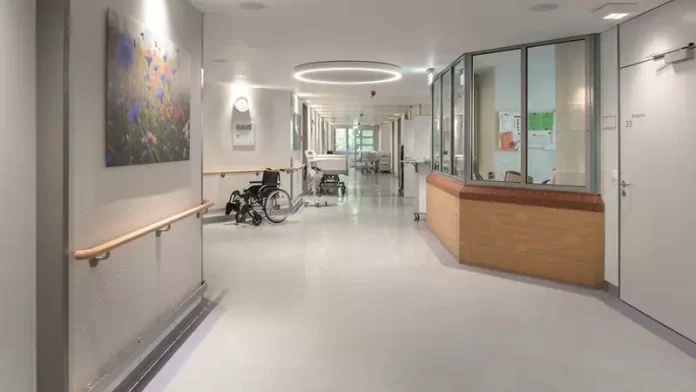The BG Klinikum Unfallkrankenhaus Berlin, a casualty hospital, has been using nora rubber flooring since 1997. The floor coverings are still delivering top-class performance.
In 1997, the British Crown Colony of Hong Kong was returned to China, the world mourned Princess Diana and the people of Germany were brought together by the flooding of the River Oder. In the same year, the BG Klinikum Unfallkrankenhaus Berlin (ukb) opened in the Marzahn district of Berlin. What started with 400 employees is now a renowned healthcare campus that employs 2000 people on the Blumberger Damm. The ukb has 25 faculties and departments, its own admissions ward, 26 wards and over 730 beds. It functions as a tertiary care trauma centre and also offers secondary care for districts in the east of Berlin.
The A&E is one of Germany’s most modern and handles 60,000 patients every year. In a tertiary care hospital the interior and the floor coverings in particular must of course meet the highest standards. Those responsible therefore decided on rubber flooring back in 1997. There are almost 12,000 m2 of norament and noraplan throughout the entire hospital. These multifaceted, indestructible, German-made floorings are easy to clean and economical to maintain. Their high quality and wear-resistance means that they also last for many decades and so fulfil sustainability criteria.
Flooring that stands up to heavy loads and footfall
As a medical facility of the German Statutory Accident Insurance Association (DGUV), the hospital treats people after accidents at work and people who require medical treatment as a result of an occupational disease. A tailored therapy concept is developed for each insured person. The hospital also has a centre for physical therapy and rehabilitation, a research centre, a centre for emergency training and its own rehabilitation clinic on site. These buildings also have rubber flooring. Torsten Gundlack, Head of Construction at the Construction and Technology Department, has worked at the ukb since 2010.
“After all these years with nora rubber flooring, we are still extremely satisfied, particularly with regard to their immaculate appearance and favourable life cycle costs”, he says. Like his predecessors, he has chosen rubber flooring for all the construction and renovation projects at the ukb. “Nothing can stop this robust flooring”, says Gundlack. “Not the constant bed traffic, not the never-ending movement of equipment and not the huge number of patient feet, crutches and wheelchairs.”
Easy to clean and economical to maintain
Gundlack is also very happy with how easy it is to maintain nora flooring. “The fact that we do not need to coat the flooring simplifies work for the cleaning staff and saves us effort in terms of organisation”, he says. The surface of the nora flooring is so thick that it does not ever require coating, deep cleaning or re-sealing. This is a huge advantage for areas such as A&E, which must always remain open and cannot be closed for cleaning. A damp mop is all that is required to clean both norament and noraplan.
This is a critical benefit because maintaining floor coverings (cleaning, regular recoating and refurbishment costs) can place a heavy burden on hospital budgets. The product with the cheapest initial purchase price is not always the most economical solution in the long term. Purchase price alone usually only accounts for just under ten percent of a floor’s total life cycle costs and experience shows that maintenance accounts for over 90 percent. Service life therefore often proves to be the main cost driver and rubber flooring offers a clear advantage such cases.
Decades of durability: a sustainable solution
The service life of nora rubber floors is above average: norament floors last for 50 years and noraplan floors last for 30 years. “nora floorings are high-quality, extremely robust and last for decades”, says Gundlack. The decision-makers at ukb chose a sustainable solution back in 1997 — a time when the word “sustainable” was not yet on everyone’s lips. The ecological advantages are obvious. Floors that last longer do not have to be replaced so quickly and this reduces the cost of new purchases.
Less waste is produced and less raw materials and energy are required to produce new floor coverings. This constitutes an important contribution to resource conservation and the reduction of greenhouse gas emissions. Gundlack also appreciates the service and support provided by the nora team. “We have reliable contact persons from the district management to the technical department”, he says. “They provide quick answers and solutions to any questions or requests we have”.
Rubber floors fulfil many requirements. Cost-effective maintenance, lasting performance, durability and decades of value retention make them the ideal solution for sustainable hospitals.




